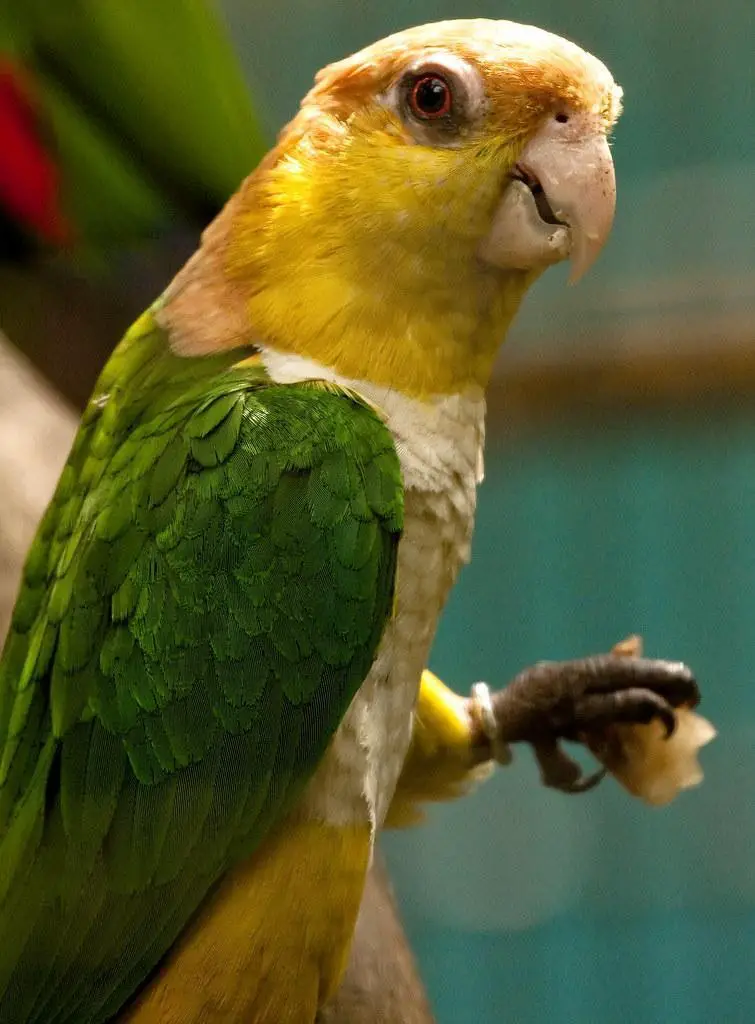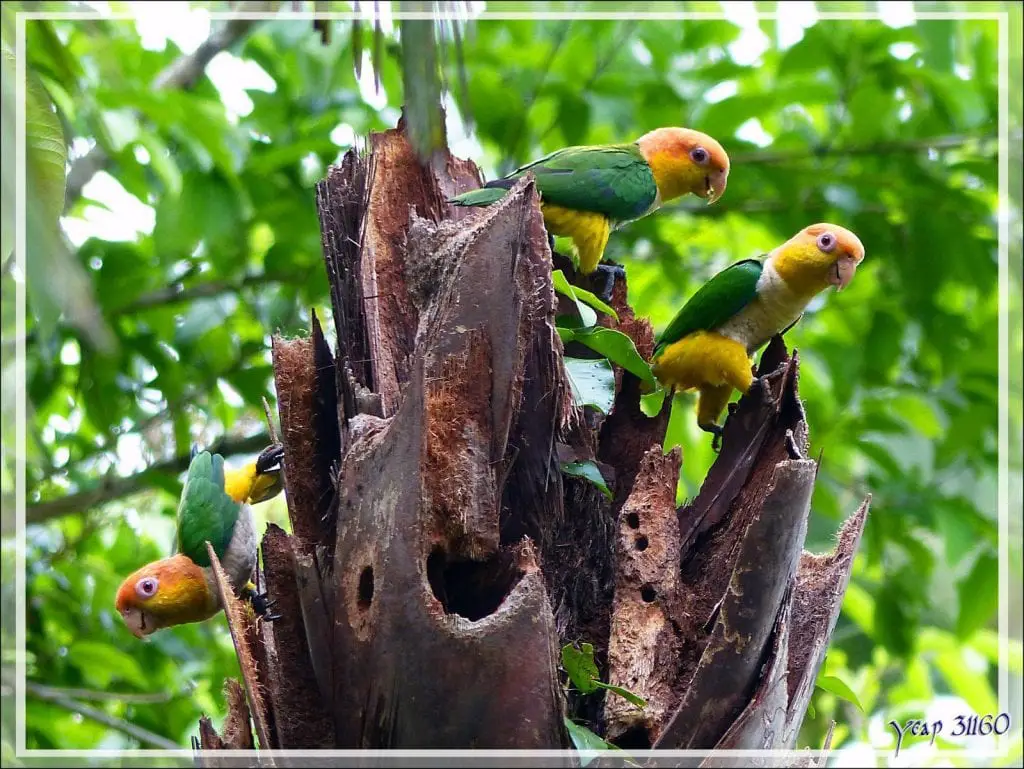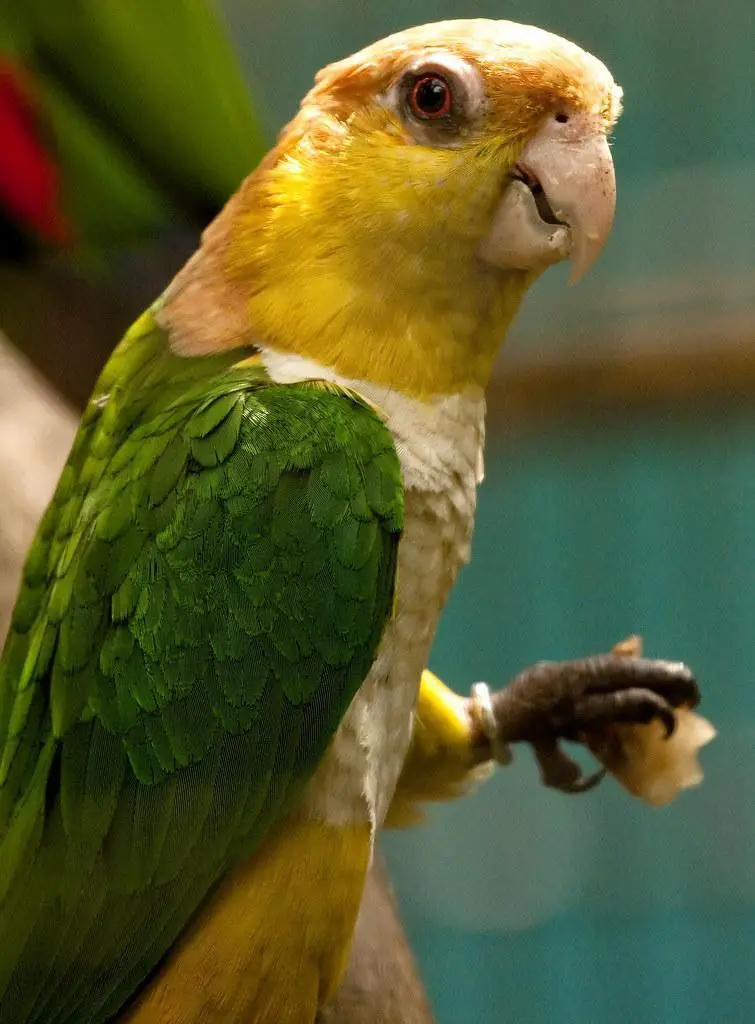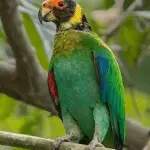Scientific Facts
| Common Name | White-Bellied Parrot |
| Scientific Name | Points leucogaster |
| Origin | Amazon River in Brazil, South America, Peru, and Bolivia |
| Habitat | Wooded and humid forest usually near the bodies of water |
| Diet | Seeds from fruits and vegetables, nuts and |
| Size and Weight | 9 inches |
| LifeSpan | 25-40 years |
Physical Appearance

White-Bellied Parrot is also named as White-bellied Caique, green-thighed parrot or clown of companion birds because they have the ability to do playful antics that makes people laugh. They have a yellow and bright orange head with a horn-colored beak. As their name implies, they have an off-white or white belly, colored green thighs, backs, and wings that are stained with chestnut brown. It also has pinkish feet and legs. They have distinct coloration, that is why they are called seven-color parrot.
Where it Can be Seen?

A is found on the wooded and humid forest habitats in the Amazon River in Brazil. They are often seen in some protected areas such as Xingu National Park, Amazônia National Park in Brazil, and in the Cristalino State Park, making it a native to South America, Peru, and Bolivia.
Habitat

They are usually found in the lowland forests, usually near the bodies of water. They prefer the wooded and humid forest where they love to nest in the hole of the trees or in high canopies.
Behavior and Temperament
They are considered exceptional parrots because of their curiosity, sociable, and independent. They live in colonies, and usually, they travel in flocks, about 30 birds in one fly. They are not like the usual parrot that talks, but they express themselves by means of whistles and high pitched tweets to show if they are threatened, happy, or just looking for attention. They are considered as the most energetic parrots. These parrots will show aggressive behavior towards other birds; that is why if taken in captivity, it is advisable to only keep them singly or in pairs.
Diet
In the wild, White-Bellied parrot eats seeds from fruits and vegetables, nuts, and fruits. In captivity, you must give them diet mixes or supplement food mix for them to get the nutritional value you needed on a daily basis. During their mealtime, they would usually travel in flocks to find food in the rainforest.
Breeding and Reproduction
Both sexes have a similar appearance, and they mature sexually by the age of 2. During their breeding season, they prefer to stay in hollows in the trees of the rainforest or in the cavities. The females lay up to 4 eggs, and they incubate it for about 27 days while it is the male’s responsibility to guard and feed her. Unlike other egg-laying mammals, they are good at parenting. They stay beside their youngs until they turned 10 weeks old.
Size and Weight
These parrots are heavy for their size that reaches 9 inches (23 centimeters) in length with a weight of 165g.
LifeSpan
They can live anywhere from 25-40 years, especially in captivity, but in the wild, expect that their lifespan is lessened.
Common Disease/Illnesses
- Salmonella
This is common for feeder birds wherein the bacteria comes from an intestinal-tract infection. If your bird is infected, your child may experience ruffled feathers and diarrhea. As soon as you see these symptoms, take your bird to a veterinarian because usually, this disease can kill them for about 3 days only. If you place more than 1 bird in a cage, remove the infected ones because this disease can spread rapidly. Salmonella is also transmittable to humans, so be sure to wear protective gear.
- Trichomoniasis
This is caused by a cell called protozoa, which are infected. This is a disease that infects almost all bird species. This disease is evident through the sores in their throat and mouth, and they do not have an appetite for food because of the inability to swallow. When a particular infested bird drops the food from its mouth, and other birds feed on it, except that the disease will be transmitted easily.
- Aspergillosis
This is a fungal infection that comes from an unsanitary environment where the bird is exposed to wet nesting materials and contaminated food. Your bird will have respiratory illnesses such as bronchitis and pneumonia due to the inhaled spores. If you notice that your bird experiences labored breathing, diarrhea, and weaknesses, take them out and for diagnosis.
- Avian pox
This viral disease is known to infect at least 60 species of birds, including the white-bellied parrot. The symptoms lesions on the unfeathered parts of their body, such as their eyelids, feet, legs, and around the beak and mouth area. In many cases, birds die when they have difficulty opening their eyes and locating their food due to eyesores. This is easily spread when mosquitoes feed on the blood of an infected bird and transfer to a healthy bird.
- Mites and Lice
Then the bird is infested with large numbers of blood-sucking mites. It may be a cause of anemia and later on death. If their nest is infested with feather mites, the adults may leave or abandon their eggs without incubating it.
Preventing Illnesses
There are a lot of reasons why white-bellied parrot gets infested with different kinds of diseases or illnesses; a common reason is due to an unsanitized housing that is why you may need to clean their cage at least once a month and make sure that before placing the birds, it should be completely dried. These types of parrots are terrestrial, if it so happens that they fight, make use of a bigger cage to avoid congestion, and to avoid the rapid spread of disease. When it comes to feeding them, make sure to give them just the right amount of food to avoid the accumulation of food in their cage that may be a cause of different bacterial infections. Always keep a close eye on your pet so that if you notice unusual behavior, you can immediately attend to them early.
Captive Breeding
These kinds of birds are usually taken in captivity as a pet because of its colorful physical appearance and because of the amusement that it gives by their energetic, fun, and lovely characteristics. They are sociable; that is why they are usually petted by children. It is good to take care of at least a pair so they can have a friend, but be sure to provide them a big cage. Another reason why they are popular to be taken in captivity because they are a hardy bird species that do not need particular care. You’ll just need to ensure that they are given lots of physical activity and healthy nutrition.
Availability-How to Get One?
They are now becoming a popular companion bird, but one of the problems in taking good care of them is that it is quite difficult to find them in different physical stores. You may need to find a breeder or a personal collector to get one.
How to Care White-bellied as a Parrot?
- Housing
Like any other animal, these birds also need to have clean housing for them to maintain their good health. The cage of this bird must be large enough even though they are just a medium-sized bird in order for them to play since they are energetic. In addition, you must ensure that their cage is in good quality of construction to avoid danger in your pet. Having a small cage is not advisable because these birds are commonly engaged in physical activities.
They may need to stay in a medium-sized cage, small cage trigger aggressiveness, and their health may suffer due to lack of exercise. Make sure that if you use stainless steel, it should be of high quality. The perfect cage dimensions for them should have dimensions of 24″ x 24″ x 24″ or a cage that has higher dimensions. The goal is to have a sufficient place for them to play around.
- Diet
The diet of caiques should be a pelleted-base diet that is enriched with fresh fruits and vegetables. The advisable food for your caiques is Nutri-Berries because it provides them balanced nutrition and fun foraging benefits. You can also avail of a pelleted-base diet in the market that is based on fruits and vegetables. Make sure that if you are to buy diet mixes, it should be enriched with nutrients to keep your pet healthy.
- Handling
Make sure to give your 100% attention to your pet, especially when they are out of their cage. It is your aim to keep them busy by giving them playing and chewing toys to relieve boredom. Make sure to keep their cage regularly cleaned as well as their food and drink dishes. Avoid using disinfectants in cleaning their cage because it is harmful to them. Also, make sure to always visit a veterinarian often fora general check-up
- Bird Baths and grooming
To avoid pest infestations, give them a shower, make sure that the water is lukewarm. If you want them to be neat looking, you may trim their wings. Trimming their wings also discourage flight, so ads to prevent the loss of your pet.
Conservation Status
White-bellied parrot is proclaimed as an endangered species in the wild due to different factors such as the destruction of their habitat, illegal smuggling, and poaching. They already have an alarming stage in the wild, especially in the rainforests of Brazil, that is why there are different sectors that breed in captivity to somehow increase their population.
Facts About White-bellied Parrot
- You can tame your parrot by means of petting, playing, and treats associated with hands. Make sure that your pet won’t perceive your hands as a threat, so never strike them or push them back into their cage aggressively. In taming them, ignoring their bad deeds, and rewarding their positive actions work.
- Make them busy to avoid aggressive behavior. Make sure that they have a toy to play with, especially during their playtime, so that they won’t perceive biting as a form of good play.
- If you are placing two birds in one cage, make sure that there is enough space because they are territorial. They tend to be aggressive if they don’t feel their own space.
- Introduce yourself to the bird and gain your bird’s trust by spending a lot of time outside their cage so that they can be familiar with you. Talk or read loudly so that they can be familiar with your voice.
- These kinds of bird species have the ability to pick up human emotions. It is advisable to only go near them if you are calm.
FAQ Section
Is white-bellied parrot cuddly?
They can be cuddly or comfortable in your hands, especially when you get them in captivity when they are young.
Is white-bellied parrot good for beginners?
They are considered social birds that are territorial. It is said that for their territorial behavior to be lessened, they must be handled more, but since they are nipping, they may not be a suitable pet for beginners.
Why does a white-bellied parrot scream?
When your parrot screams, it means that they are suffering from an illness, injury, boredom, or when they are vocalizing as an expression that they are happy. Sometimes they scream to get attention from humans.
Is white-bellied parrot affectionate?
They are known as intelligent birds that are affectionate and playful. However, they are not considered a beginner bird.
Why is my white-bellied parrot attacking me?
When your parrot is threatened, it causes traumatic experiences that may cause them to bite and show aggressiveness towards humans. Experts say that those who are aggressive were not handled properly when they were young.
How long does it take to white-bellied parrot?
You may need to hold your parrot near their cage for about 10 to 15 minutes at least two to three times a day for 4 days a week. Make sure to hold them gently so that they will be comfortable in your hands.
Can you toilet train a white-bellied parrot?
A white-bellied parrot can actually be potty trained; to do that, you must take them out from their cage, and you must be willing to clean up their mess afterward.
What do they know for?
They are known as the dancing parrot because they are fast learners and that they are fond of picking up fun tricks, making them an easy-to-train bird species.



